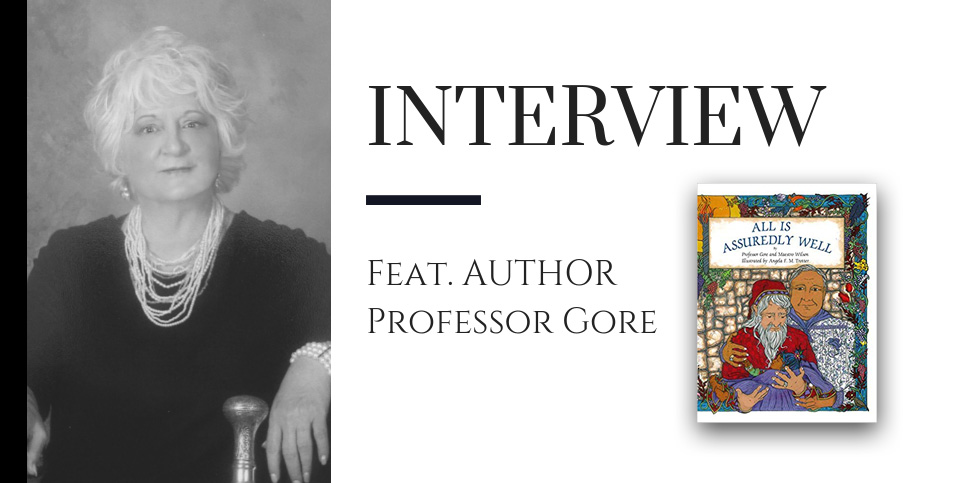Author Showcase
Sponsored* Interview
The Children’s Book Review | October 15, 2018
Professor Gore has taught school for 36 years: 16 from first grade through high school, and twenty at Midwestern State University. She is the author of nonfiction books shelved in over a thousand libraries around the world on every continent except Antarctica. She has been a professional horse wrangler and wilderness guide. She was born and raised in New Mexico, has lived in Missouri and Texas, and currently lives in Hot Springs Village, Arkansas. In this interview, we discuss her latest remarkable book All is Assuredly Well.
The Children’s Book Review: All is Assuredly Well is the quietly impactful story of same-sex couple King Phillip the Good and his elegant husband The Most Excellent Don Carlos Emiliano Felipe de Compañero y Compañero, and their wish for a baby girl of their very own. How did this story come to light?
Professor Gore: I spent two hours on my 47th birthday on the witness stand in federal court testifying against the city of Wichita Falls, Texas, when they passed a law allowing book banning at the children’s section of the public library. The law had been designed to rid the library of Heather Has Two Mommies and Daddy’s Roommate, the only two picture books at that time that depicted same-sex parent families.
I was both an Expert Witness certified by the federal court, and one of nineteen plaintiffs. I was an Expert Witness because I was a professor of Multicultural Education and Human Diversity. I was a plaintiff out of conscience.
Of course, we won the case, and because my consciousness of the problem had been raised by the case, I carefully watched the canon fail to develop over the next decade. Not until six years later, 2005, did Tango Makes Three appear. Tango is a nonfiction picture book about two male penguins at the New York City Zoo who were trying to nest. A zoo keeper gave them a fertilized egg, and they hatched it and raised baby Tango. As of 2017, Tango is still on the Top Ten list of most challenged or banned books in this country.
I hungered for little children of same-sex parents to have access to the beautiful, classic books I had as a child. No one was writing such books, so in 2012, I contacted Maestro Wilson and asked if he would co-author a book with me. I told him that I wanted to write a literary, lyrical fairy tale about two old married kings. The timid, retiring one dreamed he held a baby girl in his arms, and he ultimately had to go on The Hero’s Journey to earn her.
It works brilliantly to present this 21st century storyline in a more traditional fairytale style.
Thanks! From the beginning, I envisioned the story like the illustrated fairytale books I owned as a child.
The story assuredly has a deeper connection to make with readers than simply a king and his husband in want of a baby. Can you speak to this?
The mono-myth/ mythic journey/ Hero’s Journey resides deep in our collective unconscious. Those elements of the monomyth appropriate to a children’s book are present in ours. I will underline and italicize them.
King Phillip receives the call to adventure through the dream. He refuses the call by saying he will stay home and ask the blue star to deliver the baby to the castle. When, broken by disappointment, he leaves the castle for the first time in over two years, the star, who has turned herself into a tiny ball of light, becomes his mentor and leads him on his journey.
He encounters the first gatekeeper in the form of a biting fish, and as in most Hero’s Journeys, he must cross the water. He must tunnel deep into the earth signifying the descent into hell, and there he meets his first ally: the newt. He stumbles and falls but arises and continues. His apparent final gatekeeper is the bear that he must wrestle. The bear isn’t an enemy. He’s simply a gatekeeper to ensure that King Phillip is worthy to proceed.
The final gatekeeper and ally is actually the blue jay. In bird lore, the jay is king of the birds. In all cultures that believe in fairy circles, the circle is exceedingly dangerous, the passage between the human world and the fairy world. The jay, having found Phillip worthy through the completion of his journey, alights on his finger to show that Phillip has his imprimatur to enter the circle. Now a hero, Phillip claims the baby, which is also known as the Holy Grail, Philosopher’s Stone, Elixir of Life, and The Boon. This is his apotheosis. He has become not simply a husband, but a Father, and a Worthy Father at that.
In the monomyth, the Hero must return home and share The Boon with others. First he shares with his husband, who shares in the apotheosis to become not only husband, but Father.
Finally, news of The Boon must be shared with the world, which is no longer the same because the Hero has brought The Boon to it. The princess has come into the world, and Don Carlos shares the news with the new tolling of the bell.
The monomyth/ mythic journey/ Hero’s Journey lives deep in our collective unconscious. That’s why grown, heterosexual fathers have told me that they wept when they read the story.
We love the name Most Excellent Don Carlos Emiliano Felipe de Compañero y Compañero. Where was this name derived from?
Maestro Wilson and I created a deep and complex back story for both of the kings. Don Carlos is the fifth son of the king of the southern kingdom in our make-believe world under the blue star. He never stood a chance of becoming king and received little attention from his father. He knew he was different from the other sons (gay), and kept that difference hidden. To try to gain his father’s attention, he became a “manly man,” a hard worker, a great archer, and a general of the army. His name begins there.
Note that many symbols are hidden throughout the book, and four are embedded in the stone wall on the cover. On the far left, below the baby’s foot, are a faint pair of crossed arrows that hint at Don Carlos’s acumen with the bow.
Most Excellent and Don are both titles denoting royalty. Carlos means manly. Emiliano means hard worker. Felipe means lover of horses, but it’s also Phillip in Spanish, a connection between the husbands. (In addition, Maestro Wilson, who was born, raised, and still lives in New Mexico, is named Phillip, but he was called “Felipe” by his father.)
Compañero means companion, but that’s not why we selected it. Compañero also means equal, and we wanted to show that Don Carlos was an equal to King Phillip, not a king in the country of his birth, but a king in King Phillip’s kingdom. (Yes, their kingdom has a name, but that will be revealed in the fourth book.)
Campañeromeans bell-ringer, and that was his mother’s maiden name, so on his mother’s side, he comes from a long line of musicians, and especially master bell ringers.
Ergo, his name is Royal, Manly, Hardworking, Lover of Horses Who is a King and Musician.
What is the working relationship between authors Professor Gore and Maestro Wilson? How did the pair come together to work on the text?
Maestro Wilson was my private music teacher from the time I was eleven to thirteen years old, and my junior high band director until I was fourteen. My own father was a wonderful man, but as a busy attorney, he had little time to spend with me during the years a girl needs a father’s attention, especially between the ages of eight and fourteen when research shows us that a father’s attention is the most critical element in a girl’s development of self-esteem.
Maestro Wilson became like a second father to me and gave me the attention I needed (even paddling me when I misbehaved!), and 55 years later, he still is my second father. Although he has seven biological children, nine grandchildren, and seven great-grandchildren, he claims me as one of his own daughters.
He was the first person to recognize my linguistic gifts. My own family did not because everyone in my family was a wordsmith. At the age of nine months, I cried out in the middle of the night for my mother. She ran to my room, flipped on the light, and said, “My God, child, what’s wrong?”
I said, “Mommy, let’s visit!”
Instead of fainting that I had said “let’s visit” at nine months, she rolled her eyes heavenward, and said, “God, why, oh why did you give me such an annoying child?” Then she flipped off the light and went back to bed.
Maestro Wilson immediately recognized I was a wordsmith and encouraged me in every possible way.
When I wanted a co-author on this project (I often worked with unpublished co-authors on my non-fiction books for parents and teachers), I wanted him to be part of this father-daughter story. Although he had never written a book, as a musician, he has a wonderful ear for words and meter. He shares my love of words, and I would not have written this with anyone else in the world.
We lived 350 miles apart at the time (now 690 miles apart), so we talked on the phone every night, seven nights a week, for an hour for four months. I would write, email him a draft, and that night we would discuss it. Then the next day I would re-write.
We had to create an entire world, a kingdom within that world, an ethos of that kingdom, two kings and their entire life histories, and much else that is not in this book. For example, after listening to King Phillip sing to the blue star for a year, all the birds in the kingdom flew to Her in mass to intercede for him. They said, “Blue Star! We have many babies and with such ease! The king is a good man, and he asks only for one! Only one! Please help him!”
She said to the birds, “Very well. Then you must do the work I require. Go to every part of the kingdom. Take to the fairy circle all the flowers that represent the qualities that you think the child should have. When the time of fulfillment has come (seven is the number of completion in Judeo-Christian symbology), then I will make the child from the flowers.”
What qualities of being a professor and a maestro helped create this tale?
As for being a professor, it’s not qualities that helped create this tale as much as experience. My position acquainted me well with a thousand works of children’s literature, and because I have a teaching in major in English and am a scholar of the monomyth, those knowledge and skill sets helped. I also knew that by writing a story with the monomyth structure, we could create a fairytale that could be as meaningful to an adult as to a child, read at many levels.
The ear that the maestro has for rhythm and the lyrical nature of fairytales are qualities that sets our book apart. In addition, he has a playful quality that many musicians have, and his playfulness was a quality that helped us keep moving forward during the more difficult times of the writing. We probably wrote 10,000 words to get to the 800 that make up this book.
The illustrations are remarkably alluring. Who decided on the art style in which the illustrations would be created?
From the beginning, I envisioned pre-Raphaelite illustrations with a stained-glass quality. I started searching for an artist whose work reflected what I saw in my head. I looked at galleries for months and couldn’t find what I wanted. Then one day, when I was exceedingly ill (I lost my entire colon six weeks later) I walked into the annual convention of The Episcopal Diocese of Arkansas and there, in the first vendor’s booth, were the paintings of the person I had been searching for.
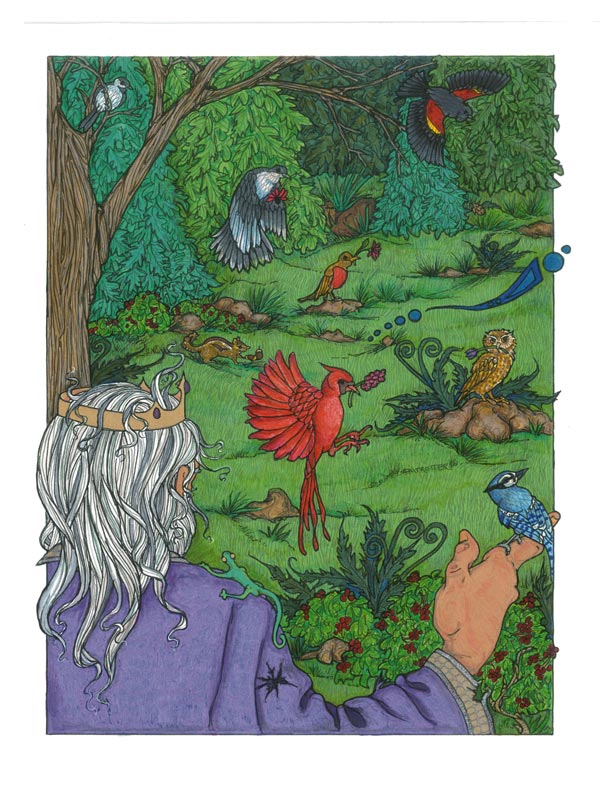
There is a very specific use of colors throughout to depict the emotions and transformation of King Phillip the Good. Please tell us about this.
Our artist, Angie F. M. Trotter, decided that the evening sky should be moving blues and purples to reflect the mood. I wanted a rainbow sky to symbolize a kingdom where “hearts, not parts” were the keys to love, so she made the day-sky seen through windows a rainbow.
The entry into the forest was dark, bordered by dark thorny vines to symbolize the danger of the journey.
Once the baby appeared on the scene in the fairy circle, Angie threw color all over the pages.
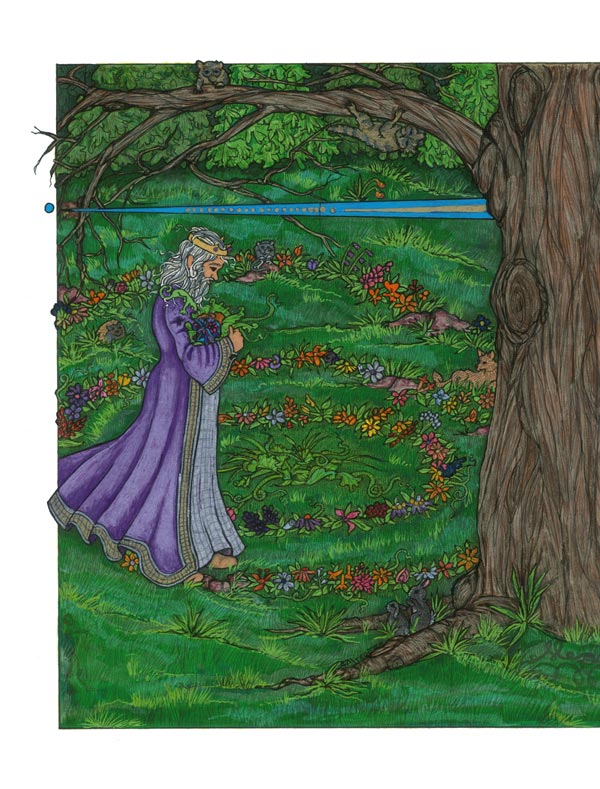
On the king’s return journey, wherever the baby has been carried, flowers explode in the foreground and all the way up the mountains. Ahead of the king and baby are few flowers, but once the child has passed, the world explodes in color. In addition, the castle windows are always dark until the baby has brought warm yellow light and life to the castle.
Note that on the front cover, when King Phillip is in apotheosis as Worthy Father, instead of the purple/blue he has worn throughout, he is attired in red. Red is the color of love and courage, so we chose that for his nightclothes to show both his great love and that he is now a man of courage. (We tried solid red, but he looked like a skinny Santa Claus, so Angie made a tartan pattern.)
Don Carlos is always shown (except for his nightclothes) in white for virtue, with blue and purple-flowered vines. They represent not only fidelity and strength, but a connection to Milliflora, whose hair has blue and purple woven into the black.
I had told Angie that when Milliflora was older, her hair would turn blue and purple (like her mother, Blue Star) from strong emotion, but Angie insisted that she must have blue and purple in her hair from the beginning, and that it would be reflected in Don Carlos’s clothing. The colors in his clothes are pale in the book until King Phillip presents her to Don Carlos, and then the clothing colors are more saturated.
How many more picture books can we expect from this dynamic trio?
Artist Angie already has the second book in her hands. Most Assuredly Well tells the story of Don Carlos’s Hero’s Journey. On Milliflora’s second birthday, she flies away on the back of a terrified turkey buzzard. Don Carlos must take his Hero’s Journey to bring her home, but a hero’s journey that will transform him from a brave warrior into a man who humbles himself and heals, rather than slays dragons.
We have a total of seven books in the series: two picture books; an illustrated book; an easy reader; and increasingly advanced chapter books, ending with a YA when she is seventeen and ready to be crowned queen.
Is there anything else you would like to share with our readers about All is Assuredly Well?
First, I would say that symbols are hidden throughout. Some are embedded in the stonework and the borders. Others are in plain view.
For example, on the cover, the stone wall represents Stonewall, the beginning of the LGBTQI revolution. In fact, we waited until July 1, 2018, to release the book because that was the first day of the fiftieth anniversary of Stonewall.
Faintly hidden within the cover’s stonework are the crossed arrows of Don Carlos, two interlinked hearts, an ankh, and a trinity.
Each large flower and bird was researched by Artist Angie and selected for its symbolic significance. For example, on the cover, the leaves of the Japanese maple are called “baby’s hands” and symbolize peace and great blessings. The red rose symbolizes love.
The raven in the corner becomes Milliflora’s advisor in a later book, and in Norse mythology, is the symbol of wisdom. The ever-present newt is said to be able to live in fire and be able to extinguish fire, and it can kill an enemy with its saliva, making it a great, if oddly unexpected, protector of the family.
I would say that we have been surprised by the number of people who have said the book shouldn’t be marketed primarily to same-sex parent families. Some heterosexual couples have told us that it describes their difficult journey to adoption. Those who have needed fertility treatments said that they related to the story. Others have said, “We’re a straight couple who want our children to understand that all kinds of families exist, not only those families who look like ours.”
Perhaps most surprising to me were the heterosexual men who told me that it’s the ultimate story of their struggles to become a worthy father, and that they cried when they read it.
Finally, because I live in a senior citizen’s community, I have been surprised by the number of people who have said that they want to share it with their grandchildren because they want them to know that family exists wherever people love and care for each other. Shared DNA not required.
—
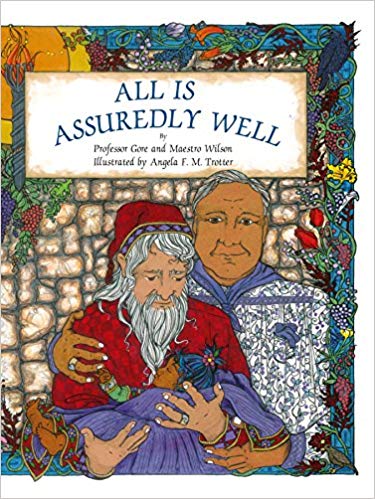 All is Assuredly Well
All is Assuredly Well
Written by Professor Gore and Maestro Wilson
Illustrated by Angela F. M. Trotter
Publisher’s Synopsis: With a book cover and illustrations as pretty as a sunlit, stained glass window, All is Assuredly Well is the quietly impactful story of King Phillip the Good and his elegant husband, The Most Excellent Don Carlos Emiliano Felipe de Compañero y Compañero, and their wish for a baby girl of their very own. A traditional fairytale blessed with a modern storyline that is ready to be told, All is Assuredly Well is written as beautifully as the field of a thousand flowers referenced within the book’s own pages. The authors wonderfully weave in old English to set the old-style tone, and readers that take well to customary tales will revel in new vocabulary words such as forsooth and sonorous. Almost like a special kind of book magic, the pages offer serenity through the repetitive phrase of “All is assuredly well.” Read aloud or read in silence, All is Assuredly Well is highly recommended. Read our complete review »
Ages 4+ | Publisher: Camille Lancaster Literary Children’s Books | 2018 | ISBN-13: 978-0999888001
Available Here
Book Trailer
About the Authors
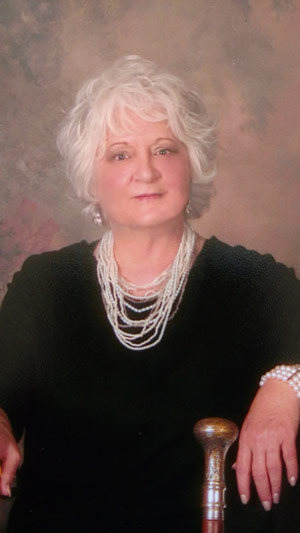
Professor Gore has taught school for 36 years: 16 from first grade through high school, and twenty at Midwestern State University. She is the author of nonfiction books shelved in over a thousand libraries around the world on every continent except Antarctica. She has been a professional horse wrangler and wilderness guide. She was born and raised in New Mexico, has lived in Missouri and Texas, and currently lives in Hot Springs Village, Arkansas.

Maestro Wilson was Professor Gore’s music teacher and junior high band director. He has been like a second father to her for 55 years, ever since he started teaching her clarinet when she was eleven years old. He was a public school band director for 28 years. He is also a composer, and in addition to being able to play every band instrument, is an accomplished campañero (bell ringer). He is a life-long resident of New Mexico and speaks English, Spanish, and music.
About the Illustrator

Illustrator Angela F. M. Trotter’s work is deeply influenced by her spiritual life and the atypical migraines that affect her daily. Her art helps her cope with the constant disability of her migraines. Her art degree is in photography and drawing. She lives in Blytheville, Arkansas with her therapy dog, Bart, and her Episcopal priest husband. This is her first book. She is currently working on the sequel, Most Assuredly Well.
The Author Showcase is a place for authors and illustrators to gain visibility for their works. This interview, Professor Gore Discusses All Is Assuredly Well, was sponsored* by Camille Lancaster Literary Children’s Books. Discover more great writing and illustrating artists in our Showcase.

